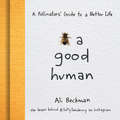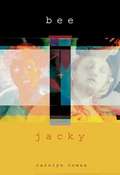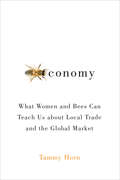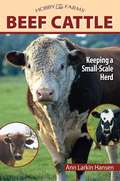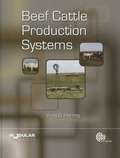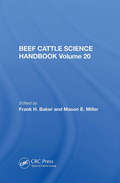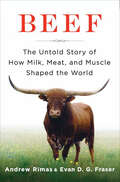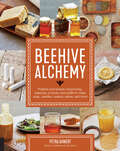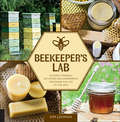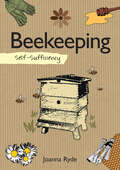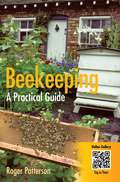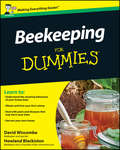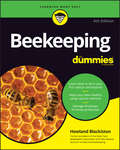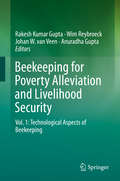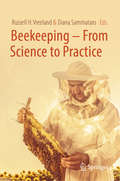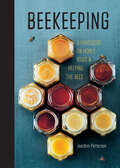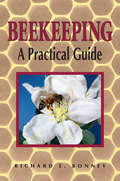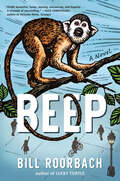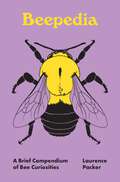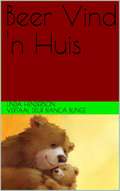- Table View
- List View
Bee a Good Human: A Pollinators' Guide to a Better Life
by Ali BeckmanCombining inspiration, humor, and entomology, Instagram artist Ali Beckman (@SoFlyTaxidermy) is the internet's go-to gal for bug-related content that makes you a happier human. Beckman's witty comics, which use actual insects in everyday situations, illustrate the importance of pollinators as well as body positivity and mental health awareness. Using creatures that are donated, purchased, or found dead to create amusing cartoons, Bee a Good Human highlights the integral role of insects in our environment while also demonstrating we all have a part to play in this world. Beyond bugs, Beckman's art speaks to the value of self-love as she shares a narrative of growth and finding confidence within.Bee a Good Human features the best of Beckman's @SoFlyTaxidermy Instagram art. With 106 color illustrations, many of which have never appeared online, this gift of a book will make you consider the bigger picture—and laugh a little too.
Bee and Jacky
by Carolyn ComanThirteen-year-old Bee resumes the physical relationship she has had in the past with her seventeen-year-old brother Jacky, a move that forces them to confront their personal histories.
Beeconomy: What Women and Bees Can Teach Us about Local Trade and the Global Market
by Tammy HornA fascinating study that &“opens a window on the world of beekeeping and female beekeepers&” (Lexington Herald-Leader). From Africa to Australia to Asia, women have participated in the pragmatic aspects of honey hunting and in the more advanced skills associated with beekeeping as hive technology has progressed through the centuries. Who are the women who keep bees and what can we learn from them? Beeconomy examines the fascinating evolution of the relationship between women and bees around the world. Bee expert Tammy Horn profiles female beekeepers, describing their work and how they manage it; the sense of community they enjoy; how beekeeping is relevant to questions about globalization and politics—and how it provides an opportunity for a new sustainable economy, one that takes into consideration environment, children, and family needs.
Beef Cattle
by Ann Larkin HansenHobby Farms Beef Cattle: Keeping a Small-Scale Herd for Pleasure and Profit, written by Ann Larkin Hansen, serves as an excellent introduction to raising cows for food or simply to graze while mowing and fertilizing the pasture. This colorful guide offers experienced hobby farmers and beginners all of the essential information necessary to purchase and maintain a small herd of beef cattle. While managing her own hobby farm in Wisconsin, Hansen shares her expertise in all things farm and has authored numerous books such as Making Hay, The Organic Farming Manual, and Finding Good Farmland. In this comprehensive book Beef Cattle, Hansen corrals the hobby farmer into the world of cowboys and cowgirls: she begins, "Beef cattle are as much at home on the hobby farm as they are on the range." This colorful primer begins with the basics, from biological traits and breeds to behavior and life cycle, and describes exactly what's required for a hobby farmer to maintain a herd of cattle-the four F's-fencing, feed, fields, and facilities. Given the expense involved in the purchase and maintenance of beef cattle, all hobby farmers will welcome Hansen's sound and sensible advice on buying the right cattle, whether steer calves for meat or breeding stock for building up a herd. The buying chapter helps farmers focus on what to look for when selecting cattle; how cows, heifers, and bulls are priced; where to purchase; and how to get cattle to your farm. The feeding and nutrition of cattle is a complicated topic, and Hansen breaks it down into the three basic components that every keeper needs to understand: pasture, hay, and grain. With directness and clarity, she explains the ins and outs of grazing, selecting ideal foodstuffs, using salt and minerals, and maintaining good weight on the herd. The reader can rely on her expert advice to learn the fundamentals of handling cattle, including herding, loading, and transporting cattle, as well as keeping beef cattle healthy through preventive methods, vaccinations, parasite control and veterinary assistance. For hobby farmers planning to breed their livestock, Beef Cattle includes a chapter on pairing cows and heifers, the actual breeding, artificial insemination, the care of pregnant cows, calving, caring for the young, and weaning calves. The final chapter of the book "Marketing and Processing Your Cattle" is geared toward hobby farmers looking to get beef processed, grade meat, and sell the final product. Sidebars of fun trivia, stories from farmers, and useful advice appear throughout the handbook. A glossary of over 100 terms; an appendix of health issues; a resource section of useful websites, books, and periodicals; and a detailed index complete the book.
Beef Cattle Production Systems
by Andy HerringThis textbook provides an integrated view of beef cattle production with a systems based approach, discussing the interrelationships of a broad range of aspects with the overall goal of optimising cattle production. This book provides the background to allow cattle producers to match their production environments with genetic, management, and marketing opportunities for sustainable beef production globally. This logic and resulting considerations can then be tailored to address specific regional challenges and opportunities worldwide. Considerations and examples for extreme situations will be provided, such as very small herds, very large herds, communal-group situations, and minimal artificial input systems. This practical book will be important reading for upper level undergraduate and postgraduate students in animal and veterinary science, producers, extension workers and veterinarians.
Beef Cattle Science Handbook, Vol. 20
by Frank H. BakerThe 1984 International Stockmen's School Handbooks include more than 200 technical papers presented at this year's Stockmen's School, sponsored by Winrock International. The authors of these papers are outstanding animal scientists, agribusiness leaders, and livestock producers who are expert in animal technology, animal management, and gene
Beef: The Untold Story of How Milk, Meat, and Muscle Shaped the World
by Andrew Rimas Evan D. FraserThe cow. The most industrious animal in the world. A beast central to human existence since time began, it has played a vital role in our history not only as a source of food, but also as a means of labor, an economic resource, an inspiration for art, and even as a religious icon. Prehistoric people painted it on cave walls; explorers, merchants, and landowners traded it as currency; many cultures worshipped it as a god. So how did it come to occupy the sorry state it does today—more factory product than animal?In Beef, Andrew Rimas and Evan D. G. Fraser answer that question, telling the story of cattle in its entirety. From the powerful auroch, a now extinct beast once revered as a mystical totem, to the dairy cows of seventeenth-century Holland to the frozen meat patties and growth hormones of today, the authors deliver an engaging panoramic view of the cow's long and colorful history.Peppered with lively anecdotes, recipes, and culinary tidbits, Beef tells a story that spans the globe, from ancient Mediterranean bullfighting rings to the rugged grazing grounds of eighteenth-century England, from the quiet farms of Japan's Kobe beef cows to crowded American stockyards to remote villages in East Africa, home of the Masai, a society to which cattle mean everything. Leaving no stone unturned in its exploration of the cow's legacy, the narrative serves not only as a compelling story but as a call to arms, offering practical solutions for confronting the current condition of the wasteful beef and dairy industries. Beef is a captivating history of an animal whose relationship with humanity has shaped the world as we know it, and readers will never look at steak the same way again.
Beehive Alchemy: Projects and Recipes Using Honey, Beeswax, Propolis, and Pollen to Make Soap, Candles, Creams, Salves, and More
by Petra AhnertA comprehensive introduction to making candles, home and body products life from the author of Beeswax Alchemy.Beehive Alchemy is a continuation of Petra Ahnert’s bestselling Beeswax Alchemy. With this new book, beekeepers (and bee lovers) will learn about the benefits and attributes of beeswax, honey, propolis, and more alongside a full range of projects and techniques to process and harness the amazing gifts of bees. Inside, you’ll find instructions to make Ahnert’s award-winning hand-dipped birthday candles, the classic French dessert canele bordelais, and much more, including:Alchemy for the BodyLiquid soap with honeyBeard balmOlive and honey lotionAlchemy of LightTaper candlesTea lightsPillarsAlchemy for the HomeFurniture polishWaxed cotton food wrapsWoodcutter incenseAlchemy in the StudioBeeswax crayonsEncausticBatikAlchemy in the KitchenCookies and candiesBeveragesFermentationsWhether you keep bees or just love them, Beehive Alchemy will become your go-to comprehensive guide for hive-to-home creations.Praise for Beeswax Alchemy:“An excellent introduction and solid technique instruction to make candles, lotions, and soaps with beeswax. . . . The true strength of this book is its instructions for making homemade body products. While similar in coverage to Leeann Coleman and Jayne Barnes’s Honey Crafting, Ahnert’s book provides better body products and more detailed technical instruction. Strongly recommended.” —Library Journal“This is the book I’ve been waiting for. Excellent instructions. Bountiful information. Beautifully done.” —Kim Flottum, author of The Backyard Beekeeper and editor of Bee Culture magazine
Beekeeper's Lab: 52 Family-Friendly Activities and Experiments Exploring the Life of the Hive
by Kim Lehman"Very informative and fun . . . Science, art, bee care, 52 different labs to entertain, delight, educate and inspire everyone in your family." —A Net in TimeBeekeeping's popularity as a hobby continues to skyrocket. And now, with Beekeeper's Lab, you can fill the year ahead with weekly activities from around and about the hive—including art projects, recipes, experiments, garden activities, and more!Bees are important to local ecosystems,now more than ever. Whether you're already a beekeeper, or are still considering getting your first hive, Beekeeper's Lab has projects perfect for you. This extensive guide book features 52 beekeeping and hive-inspired projects to keep you involved with your buzzing friends all year long.The tutorials are brief, accomplishable, rewarding, and best of all, they are presented in afriendly lab-style format. Try a new technique each weekwith how-tos and sidebars with tips that are perfect for the whole family. Beekeeping is a fun hobby to enjoy, plus, who doesn't want their own supply of honey?
Beekeeping (Self-Sufficiency)
by Joanna RydeLearn what all the buzz is about with this guide to the fascinating and sustainable hobby of keeping bees. Plus: honey recipes for food and skin care!Beekeeping is about management, control and learning to understand the honeybee. It can also become a very enjoyable and sociable pastime—visiting others&’ hives and picking up vital hints and tips is all part of the fun—and farming and eating honey that your own bees have produced is a pure delight. Joanna Ryde covers all aspects of beekeeping, from the basic tools and equipment needed for setting up a hive to detailed advice on when to harvest honey and honey-inspired recipes, from delicious cakes to beauty products. This really is the definitive guide for anyone thinking of keeping bees.
Beekeeping - A Practical Guide: A Practical Guide
by Roger PattersonA practical book for new beekeepers and those interested in keeping their own bees, explaining everything they need to know to get started. It also covers how to make your garden attractive for bees. Published to coincide with the biggest beginners' day for beekeeping which takes place in February each year.
Beekeeping - A Practical Guide: A Practical Guide
by Roger PattersonA practical book for new beekeepers and those interested in keeping their own bees, explaining everything they need to know to get started. It also covers how to make your garden attractive for bees. Published to coincide with the biggest beginners' day for beekeeping which takes place in February each year.
Beekeeping For Dummies
by Howland Blackiston David WiscombeThe fast and easy way to start and maintain a hiveBeekeeping For Dummies is a practical, step-by-step beginner's guide to beekeeping. It gives you plain-English guidance on everything you need to know to start your own beehive, from buying the right equipment, sourcing bees, and locating your hive to maintaining a healthy colony and harvesting honey. Plus, you'll get the latest information on the causes and effects of bee disease, colony collapse disorder, and the impact the sudden disappearance of the honeybee has on our environment and economy.Here, you'll get trusted information on beekeeping in the UK, specifically written to address climate, buying equipment, locating hives, the local impact of colony collapse disorder and ways to avoid or minimise the risk to your hive, seasonal beekeeping tasks, local beekeeping associations, and updated content on urban beekeeping. Understand the anatomy of your bees Learn techniques and tips for harvesting, bottling, packaging, and selling honey Discover the benefits of beekeeping Learn techniques on obtaining and hiving your beesIf you're a beginner beekeeper, taking a beekeeping course, or just have an interest in the plight of the honeybee, Beekeeping For Dummies has you covered!
Beekeeping For Dummies
by Howland BlackistonBeekeeping For Dummies, 2nd Edition reviews the tools of the trade, including complete instructions for building and maintaining beehives; offers detailed and easy-to-follow guidelines for all phases of honey production--including harvesting, bottling, packaging and marketing your honey; explores theories into the recent unexplained collapse of colonies and its environmental and economic on society; and provides new information on mites and diseases and recommend changes in bee medication and treatments.
Beekeeping For Dummies: 4th Edition
by Howland BlackistonThe single best and most comprehensive guide for prospective, new and experienced hobbyist beekeepers Beekeeping For Dummies, 5th Edition, is one of the most popular titles in the For Dummies series available today. Including the latest information regarding every aspect of backyard beekeeping and honey production, this book describes how to get started, how to care for and safely handle bees, and how to maintain healthy and productive colonies. This book is loaded with up-to-date, practical examples and helpful illustrations of proven techniques and strategies for both new and seasoned hobbyist beekeepers. Some of the updates for this brand-new edition include: New information regarding the critical role that nutrition plays in the health and productivity of your bees News about the latest beekeeping products, medications, and all-natural remedies Information regarding dozens of helpful beekeeping resources Redeemable coupons from beekeeping suppliers that save the reader money Beekeeping For Dummies embodies the straightforward and simple approach made famous by the For Dummies series. Each and every reader will benefit from its accessible and approachable take on beekeeping.
Beekeeping for Beginners: How To Raise Your First Bee Colonies
by Amber BradshawHelp your hive thrive with this guide to beekeeping for new-bees.Wouldn't it be great to raise your own bees, have a fresh supply of honey, and bring thousands of healthy pollinators into your yard? Beekeeping for Beginners is a simple, step-by-step guide that helps you learn the fundamentals of modern beekeeping. You (and your bees) will be buzzing with delight.From picking the right hive and bringing your bees home to surviving winter and collecting honey, experienced beekeeper Amber Bradshaw takes you on an easy-to-follow journey through your first year of beekeeping and beyond.Beekeeping for Beginners includes:Just the essentials—Learn everything you need to know to begin your first colony—written with brand new beekeepers in mind.Modern beekeeping—Start your colony off right with guides that feature the newest practices and current, natural approaches.Learn to speak bee—Clearly defined terms and a complete glossary will have you talking like a pro beekeeper in no time.Begin your beekeeping the right way—and avoid getting stung by mistakes—with Beekeeping for Beginners.
Beekeeping for Poverty Alleviation and Livelihood Security: Vol. 1: Technological Aspects of Beekeeping
by Rakesh Kumar Gupta Wim Reybroeck Johan W. Veen Anuradha GuptaThis Book intends to address all aspects needed to develop beekeeping into a powerful instrument of rural development and will focus on beekeeping as a tool for Poverty Alleviation and Livelihood security. In the backdrop of the social and economic issues of the people living in poverty region, the book aims to delineate specific motivation approaches to engage them in beekeeping and will serve as a guide for effective marketing through diversification and value addition of bee products. Nevertheless, marketing and environmental issues will remain an important component of this book. The aim is also to focus on indirect benefit of beekeeping so that it is integrated with farming and nature conservation. Other topics include ensuring the provision of practical techniques in handling and management of bees. It will provide detailed information on good contacts with policymakers and authorities; and channels for attracting finance especially in the third world countries. An interdisciplinary approach is the key feature of the book and it will also focus on few case histories and success stories to encourage the reader to take up beekeeping as a new venture gradually in a phased manner like traditional-transitional and modernised beekeeping. With the publication of this book, we hope to hand out a practical guide that will assist all those who are involved in beekeeping for development. We hope it will stimulate beekeeping as an integrated activity with farming and nature conservation and will serve in many households for poverty alleviation and livelihood security.
Beekeeping – From Science to Practice
by Diana Sammataro Russell H. VreelandThis book will help beekeepers understand the fundamentals of beekeeping science. Written in plain and accessible language by actual researchers, it should be part of every beekeeper's library. The respective chapters not only present raw data; they also explain how to read and understand the most common figures. With topics ranging from honeybee nutrition to strains of Varroa resistant bees, from the effects of pesticide chemicals to understanding diseases, and including a discussion of venom allergies, the book provides essential "knowhow" that beekeepers will benefit from every time they inspect their hives. Further, each chapter ends with the author explaining how beekeepers can (or cannot) directly utilize the information to enhance their beekeeping operation. The text is structured to facilitate ease of use, with each author addressing the same four issues: 1) What are the specific purposes or goals of these experiments? Or more simply: what have these studies taught us? 2) How should a non-scientist read the data generated? 3) What are the key points in relation to practicing beekeepers' goals? 4) How can the data or techniques discussed be applied by beekeepers in their own apiaries? This approach allows readers to look up specific information quickly, understand it and even put it to use without having to read entire chapters. Further, the chapters are highly readable and concise. As such, the book offers a valuable guide and faithful companion for all beekeepers, one they can use day in and day out.
Beekeeping: A Handbook on Honey, Hives & Helping the Bees
by Joachim PettersonFrom pollination, gardening, beekeeping, and recipes, this guide has everything amateur and veteran apiarists to keep a hive buzzing.Beekeeping might seem exotic or old-fashioned, but around the world it is becoming more and more common to find a hive or two in urban spaces and suburban backyards. Some modern beekeepers are inspired by the desire to help out the frequently beleaguered creatures, others simply enjoy fresh honey from the most local of sources—the backyard garden. This multifaceted book discusses your options for setting up a hive almost anywhere, how to plant a bee-friendly garden, and how to harvest and use your very own honey. Not only is it a great hobby, you’ll also be rewarded with a plentiful supply of honey that you can use in tea as well as for cooking, baking, and perhaps even lip salve and skin cream.Everything the modern day beekeeper needs and more:-Becoming a Beekeeper-Setting Up Your Hive-Getting the Right Gear-Planting a Bee-Friendly Garden-Trouble-Shoot Your Hive-Harvest the Honey-Plan for the WinterThe honeybee is one of our greatest natural resources; bees work hard to pollinate our gardens and do an important job that we couldn’t do without. But bees are finding it increasingly difficult in the world that they share with us. States are reporting a hive of activity in the “backyards” of rural and urban beekeepers. In fact, many states are beginning to alter preexisting ordinances in order to encourage more individuals to start beekeeping. No other hobby can simultaneously help save the world and bring sweet treats to your table!
Beekeeping: A Practical Guide
by Richard E. BonneyKeep your own bees and enjoy delicious golden honey from your own backyard. With his respect and admiration for bees evident on every page, Richard E. Bonney describes how to acquire bees, manage a hive, prevent and treat diseases, and extract a crop of honey. Enthusiastic beekeepers of every stripe and experience level will benefit from Bonney’s astonishing knowledge of the craft — from beekeeping history and honeybee biology to the complex social structure of the hive.
Beep: A Novel
by Bill RoorbachAn ebullient, funny, and hugely original novel told from the perspective of Beep, a squirrel monkey who—with the help of a brilliant young girl— forges the way forward for a planet in crisis. In this immensely enjoyable and wise novel, it takes a sweet and personable squirrel monkey, Beep, to help us see the world we live in more clearly. While intending only to go deeper and higher into the Costa Rican rain forest to find a mate, he instead meets Inga, a kindly American tween on vacation with her family. Inadvertently, Beep travels to Manhattan with Inga. With her devoted help—and a bit of inspiration from a visiting Greta Thunberg, along with a dramatic zoo liberation—Beep manages to change the destiny of the world. He even finds his monkey love. Along the way, a vast cast of engaging and perceptive animals have a great deal to say about humanity and the divisions among us, our alien cities, our strange practices, our folly, as well as our beauty, and our promise, unfulfilled. For fans of Shelby Van Pelt&’s Remarkably Bright Creatures and Dave Eggers&’s The Eyes and the Impossible, Beep is full of humor, inspiration, and remarkable new ways of understanding how we live. Urgent but never earnest in the face of the increasing threats to our planet, Beep the monkey inspires us all to stop being the problem and start being the solution, loving and laughing all the way.
Beepedia: A Brief Compendium of Bee Curiosities (Pedia Books)
by Laurence PackerAn enchanting, fact-filled treasury for the bee lover in all of usBeepedia is a one-of-a-kind celebration of bees, from A to Z. Featuring dozens of alphabetical entries on topics ranging from pollination and beekeeping to the peculiar lifestyles of cuckoo bees and carrion-eating vulture bees, this enticing, pocket-sized compendium takes you on an unforgettable journey into the remarkable world of bees.Explore the many wonders of bee morphology, behavior, and ecology, and learn about the role of bees in agriculture, art, literature, and religion. With more than 20,000 described species, bees can be found anywhere on the planet where flowering plants are pollinated by insects. With Laurence Packer as your guide, you will meet some of the most inquisitive and prolific bee experts who ever lived and marvel at the astonishing variety of wild bees and the creative methods scientists use to study them. Discover why bees have intrigued us for millennia, why Napoleon Bonaparte chose the bee as his emblem when he became emperor, where the expression &“the bee&’s knees&” comes from, and much more.With captivating drawings by Ann Sanderson, Beepedia is an informative and entertaining blend of fact, folklore, and fancy that will captivate anyone who has ever been curious about these amazing insects.Features a cloth cover with an elaborate foil-stamped design
Beer Vind 'n Huis
by Linda HendersonKlein Beer voel alleen in die wêreld. Nadat hy eendag wakker geword het en besef het dat daar geen ander bere was om hom te troos of vir hom te sorg nie, het hy besluit om op reis te gaan om iemand te vind wat hom sal lief hê. Soos jy sal vind tydens die lees van hierdie boek, lei sy soektog hom na 'n gelukkige einde.
Bees (Nature's Children)
by Joyce JamesDescribes the physical characteristics, behavior, and habitats of bees
Bees (Nature's Friends)
by Ann HeinrichsDescribes distinguishing characteristics, life cycles, and different types of bees.
